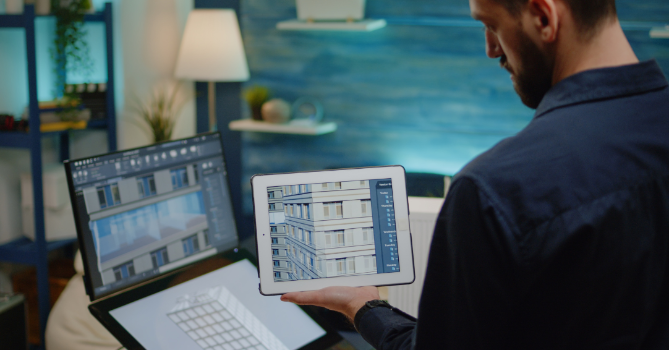
Digital Twins and BIM: A New Era for Asset Management
Introduction: The Convergence of Digital Twins and BIM
Digital Twins are becoming essential in modern asset management. These virtual models of real-world assets allow companies to monitor, manage, and optimize their buildings and infrastructure in real-time. By using data from sensors, Digital Twins provide accurate insights on an asset’s condition, helping teams make smarter decisions about maintenance, repairs, and performance improvements.
When combined with Building Information Modeling (BIM), Digital Twins become even more effective. BIM delivers detailed 3D models during the design and construction phases, while Digital Twins extend this data throughout the asset’s entire lifecycle. Together, BIM and Digital Twins enable seamless management from planning to long-term operation, making asset management more efficient and cost-effective.
In this blog, we’ll explore how this combination is transforming asset management and how companies can leverage these technologies to improve performance, save costs, and future-proof their assets.
What Are Digital Twins?
Digital Twins are digital replicas of physical assets that provide a real-time view of how those assets are performing. They collect data from sensors and other sources to mirror the actual condition of a building, system, or piece of infrastructure. This allows teams to monitor the asset’s health, track its performance, and predict issues before they arise.

A key feature of Digital Twins is their ability to update continuously. As real-time data flows in, these virtual models adapt, offering up-to-date information on everything from energy use to structural integrity. This constant stream of data helps companies make informed decisions about maintenance and operational efficiency, ultimately reducing downtime and extending asset life.
The adoption of Digital Twins is growing across various industries. In asset management, this technology offers unprecedented control over complex systems, making it easier to manage resources and optimize operations.
The Role of BIM in Supporting Digital Twins
Building Information Modeling (BIM) lays the groundwork for Digital Twins by providing detailed, data-rich models during the design and construction phases. These models contain all the necessary information about a building’s structure, materials, and systems, making them the perfect foundation for creating a Digital Twin. BIM enables accurate visualization of physical assets, allowing teams to plan and build with precision. Once construction is complete, the BIM model seamlessly transitions into a Digital Twin, continuing to serve as a valuable resource for ongoing asset management.

BIM supports the lifecycle of an asset by capturing every detail, from the design to the final build. This level of detail allows Digital Twins to mirror real-world conditions and continuously update as changes occur. By using BIM as the basis for Digital Twins, companies can ensure that their digital models reflect the true state of their physical assets, improving accuracy and reliability.
In real-world applications, BIM-driven Digital Twins have proven to be highly effective in enhancing asset performance. For example, in large infrastructure projects like airports, BIM and Digital Twins have been used to monitor energy usage, predict maintenance needs, and optimize operational efficiency. These combined technologies allow companies to reduce operational costs while extending the life of their assets, making BIM a critical tool for the future of asset management.
Benefits of Integrating BIM and Digital Twins in Asset Management
The integration of BIM and Digital Twins brings significant benefits to asset management. Together, these technologies offer improved decision-making, predictive maintenance, and greater operational efficiency. By providing a complete, real-time view of an asset’s condition, teams can make more informed decisions about repairs and upgrades. This reduces the likelihood of unexpected failures, which in turn lowers maintenance costs and minimizes downtime.

Predictive maintenance is a key advantage of combining BIM and Digital Twins. Digital Twins continuously update with data from sensors, allowing asset managers to predict when maintenance is needed before issues arise. This proactive approach can extend the lifespan of equipment and systems, saving time and money.
In practice, the BIM-Digital Twin combination has been used in projects like smart city developments and large-scale infrastructure. These projects have seen reductions in both operational costs and energy consumption. By integrating these two technologies, asset managers can optimize resources and streamline operations, ultimately leading to more efficient and cost-effective asset management.
Emerging Trends: AI, IoT, and the Future of Digital Twins
Emerging technologies like AI and the Internet of Things (IoT) are taking Digital Twins to the next level. With IoT sensors feeding real-time data into Digital Twins, assets can be monitored more closely than ever before. AI, on the other hand, helps analyze this data, spotting patterns and predicting potential issues. This combination makes Digital Twins smarter and more efficient, allowing for more accurate forecasting and asset management.

When AI is integrated with BIM and Digital Twins, it enables predictive analysis, offering deeper insights into how an asset will perform over time. This makes maintenance smarter and more proactive, reducing the chances of unexpected breakdowns and optimizing operational efficiency.
Looking to the future, Digital Twins are expected to expand beyond construction. They will be used for long-term monitoring of assets and assessing environmental impacts over time. From energy use to sustainability efforts, Digital Twins will play a vital role in ensuring assets are not only managed efficiently but also contribute to greener and more sustainable practices.
Conclusion: The New Era of Asset Management with BIM and Digital Twins
The combination of Digital Twins and BIM is revolutionizing asset management, offering greater efficiency, predictive maintenance, and smarter decision-making. By integrating these technologies, companies can monitor assets in real-time and optimize operations, reducing costs and improving performance. As the construction industry continues to evolve, Digital Twins and BIM will play an even larger role in shaping the future of asset management.
To stay competitive and future-proof their processes, companies should consider adopting Digital Twins alongside BIM. This powerful duo will continue to drive innovation, making asset management more sustainable, efficient, and data-driven in the years ahead.